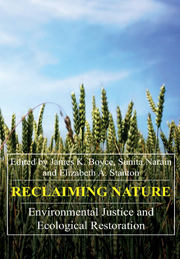Book contents
- Frontmatter
- Contents
- List of Figures and Tables
- Acknowledgements
- Introduction
- Part I ADDING VALUE
- 1 The Blessing of the Commons: Small-Scale Fisheries, Community Property Rights, and Coastal Natural Assets
- 2 Natural Resource Management and Poverty Alleviation in Mountain Areas
- 3 Harvesting the Rain: Fighting Ecological Poverty through Participatory Democracy
- 4 Net Benefits: The Ecological Restoration of Inland Fisheries in Bangladesh
- Part II DEMOCRATIZING ACCESS
- Part III CAPTURING BENEFITS
- Part IV DEFENDING THE COMMONS
- About the Contributors
- Index
2 - Natural Resource Management and Poverty Alleviation in Mountain Areas
from Part I - ADDING VALUE
Published online by Cambridge University Press: 05 March 2012
- Frontmatter
- Contents
- List of Figures and Tables
- Acknowledgements
- Introduction
- Part I ADDING VALUE
- 1 The Blessing of the Commons: Small-Scale Fisheries, Community Property Rights, and Coastal Natural Assets
- 2 Natural Resource Management and Poverty Alleviation in Mountain Areas
- 3 Harvesting the Rain: Fighting Ecological Poverty through Participatory Democracy
- 4 Net Benefits: The Ecological Restoration of Inland Fisheries in Bangladesh
- Part II DEMOCRATIZING ACCESS
- Part III CAPTURING BENEFITS
- Part IV DEFENDING THE COMMONS
- About the Contributors
- Index
Summary
Introduction
This chapter addresses community-level natural resource management and rural poverty, first by re-examining the mainstream view that blames the poor for natural resource degradation. This is followed by a comparison of the traditional and present-day systems of natural resource management in mountain areas. This helps in the identification of factors and processes contributing to resource degradation. Lessons from past systems and successful experiences of new initiatives on community forest management in Nepal and India are synthesized to suggest possible approaches to rebuilding communities' natural assets. The final section of the chapter looks at concerns and uncertainties relating to new forest-centered initiatives, and at possible ways to address these.
The crucial role of natural asset building in reducing poverty — by conserving, regenerating, upgrading and equitably harnessing natural resources, particularly, forests, pastures and crop lands — stems from the contributions of these resources towards enhancing the livelihood options of the poor (Dasgupta 1996). These include direct availability of seasonally and spatially varying supplies of bio-fuel, fodder, fiber, food items, timber and high-value products such as medicinal herbs, honey, mushrooms and vegetable dyes. The indirect services provided by forests and other natural ecosystems include stability of the micro-environment and the flow of moisture and nutrients to sustain productive farming systems.
This facilitative role of forests is all the more important in mountain regions, where due to limited accessibility and relative isolation, people's dependence on local resources is very high.
- Type
- Chapter
- Information
- Reclaiming NatureEnvironmental Justice and Ecological Restoration, pp. 55 - 88Publisher: Anthem PressPrint publication year: 2007
- 1
- Cited by



